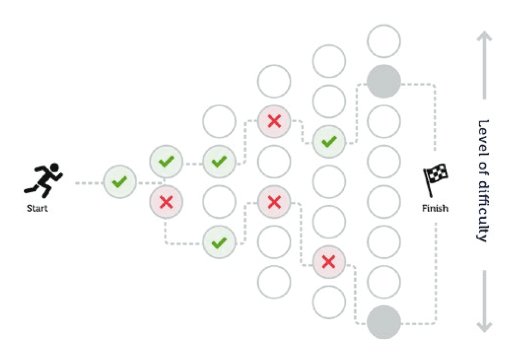Despite its many advantages, computerized adaptive testing, or CAT, isn’t used very frequently despite being a hot topic in the assessment community. We will provide you with an overview of Computerized Adaptive Testing (CAT) in this article. Please keep reading.
The Definition Of Computerized Adaptive Testing
A computer-based exam that uses unique algorithms to adjust test question difficulty for each individual test taker is known as computerized adaptive testing (CAT).
A computer adaptive test is one that adjusts in real time to the test taker’s skill level and presents test questions accordingly.
It is one method of a secure exam design that you can use to shield the information on your test from disclosure and stop cheating by test takers. Tests can now be given more quickly, with fewer questions, and with higher levels of security thanks to CAT.
How Do CATs Work?
An item bank—a group of inquiries used to gauge an assessment—forms the basis of a CAT. Each CAT can have a different number of questions, but typically four to seven are given to the person to respond to.
The first question a CAT selects to ask evaluates a variable with a middle-of-the-range function or symptom severity. A person’s estimated score is determined after they have answered the question.
The CAT algorithm then chooses the question it thinks will best improve the person’s score. After the person answers that question, their score is updated.
A CAT will keep asking questions and recalculating a person’s score until either a predetermined level of measurement precision is reached or a predetermined number of questions are asked.
Pass/Fail Rules
One of three rules determines whether the computer says you passed or failed the NCLEX:
- 95% Confidence Interval Rule
- Maximum-Length Exam Rule
- Run-out-of-time (R.O.O.T) Rule
The computer is unable to determine with 95% certainty whether a candidate passed or failed if time runs out before they have completed the maximum number of items. So, it’s necessary to apply a different rule:
- Exam failure will occur if the required number of items are not answered by the candidate.
- The final ability estimate calculated from responses to all completed items is used to determine the exam score if the candidate has answered the required number of questions.
- The candidate succeeds if the final ability estimate exceeds the threshold for passing.
- The candidate is unsuccessful if the final ability estimate is at or below the required level.
Advantages Of Computerized Adaptive Testing

The fact that CAT is effective is one of its main benefits. It uses fewer items than a conventional test to produce a score for test-takers that is just as useful. These specific advantages result from this effectiveness:
- The test goes more quickly. Examinees will test for shorter periods of time, sometimes by 50%.
- Reduced testing costs. The cost of administering tests can be reduced by saving time.
- enhanced test security The overall average exposure of the items in the pool is decreased by revealing fewer items to each examinee. This makes tasks like item harvesting and pre-knowledge cheating challenging and less lucrative. With computerized adaptive tests, each test taker receives a distinct form with (ideally) little overlap between these forms, making it challenging to cheat by copying answers during in-person test administrations. The amount of overlap between tests is primarily determined by the size and composition of the CAT’s pool of items.
- reduced weariness and boredom Each test taker will have a more enjoyable testing experience where the majority of the questions are moderately challenging because they won’t have to answer the easy and difficult questions (easy and difficult for them, that is).
Why Isn’t CAT Used More Frequently?
Because I was so eager to use the technology in 1990 and had great success doing so, I have thought about this question countless times over the past three decades.
Every other program could undoubtedly accomplish what I have, but there are a variety of possible responses to the query.
As a result, the lengthy list of just a few of the many justifiCATions people have shared for not using CAT will be personal in nature.
- “Adaptive tests require a lot of data, and my program is unable to produce the quantities needed to implement CAT.”
- “The theoretical and statistical expertise needed for adaptive tests is not something our staff possesses.”
- “Tests that are adaptive are novel and dangerous. Staying with what I know is best.”
- “Adaptive test takers will complain because they don’t like or comprehend them.”
- “A large pool of items to support a CAT cannot be created due to lack of resources.”
- “The vendor we use for test administration does not support CAT technology.”
- “My tests are running smoothly.”
- “There are numerous exam titles, and I’m confident that we won’t be able to create computerized adaptive tests for all of them.”
- “The benefits offered by CAT are not something I need or understand.”
These goals are realistic, especially for small testing programs. Every time I’ve used computerized adaptive tests in the past, I’ve had easy access to lots of data, programs to compute the necessary statistics, programs to administer the test, and other tools and support as needed.
I felt the validity of these counterarguments much more strongly after implementing CAT with a very small certifiCATion program recently. However, it became crucial to take a more comprehensive approach to computerized adaptive tests.
Therefore, testing programs with limited resources should take note that these and other obstacles can be overcome with creative solutions and relatively easily.
Conclusion
An exam that is computer-based and uses algorithms to adjust test question difficulty levels based on a test taker’s past correct and incorrect answers is known as a computerized adaptive test (CAT). To select the most applicable next question, a CAT uses the Item Response Theory to provide questions that will sharpen the estimate of the final score.

